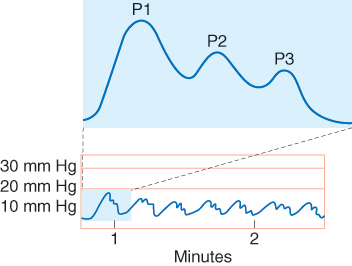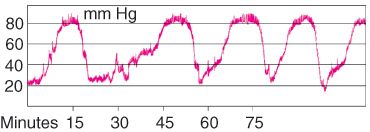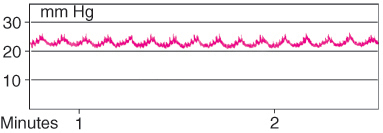| Box 17-2 | Interpreting ICP Waveforms |
Sustained periods (>5 minutes) of ICPs greater than 20 to 25 mm Hg are considered significant and can be extremely dangerous. Sustained periods of ICPs greater than 60 mm Hg are usually fatal (Morton & Fontaine, 2018). A normal waveform correlates with hemodynamic changes. Plotting extended periods of increased ICP measurements over time provides patterns known as A, B, and C waves (waveform trends). Normal Intracranial Waveform A normal ICP waveform typically shows a steep upward slope followed by a downward slope with three descending peaks that correlate with hemodynamic changes (forces related to the circulation of blood). P1 correlates with systole; P2 most directly reflects the state of intracranial compliance, so as ICP rises, P2 elevates; P3 tapers down to correlate with diastole (Morton & Fontaine, 2018). In normal circumstances, this waveform occurs continuously and indicates an ICP between 0 and 15 mm Hg—normal pressure. The amplitude of P2 may exceed P1 with increased ICP or decreased intracranial compliance (Morton & Fontaine, 2018). A Waves A waves are produced by spontaneous, transient, rapid increases of pressure over a period of time (ICP values of 50 to 200 mm Hg, lasting 5 to 20 minutes) and are associated with compromised cerebral perfusion and deteriorating neurologic status. B Waves B waves, which appear sharp and rhythmic with a sawtooth pattern, are shorter (30 seconds to 2 minutes) with ICP values of 20 to 50 mm Hg. They are seen in patients with intracranial hypertension and decreased intracranial compliance. B waves are an early indication of deteriorating neurologic status and may precede A waves. C Waves C waves are rapid and rhythmic, but they are not as sharp as B waves. C waves are associated with ICPs as high as 20 mm Hg that persist for less than 5 minutes. They may fluctuate with respirations or systemic blood pressure changes and are without clinical significance (AACN, 2017; Burns & Delgado, 2019). Source: Adapted from American Association of Critical-Care Nurses (AACN). (2017). In D. L.Wiegand (Ed.). AACN procedure manual for high acuity, progressive, and critical care (7th ed.). Elsevier; Burns, S. M., & Delgado, S. A. (2019). AACN Essentials of critical care nursing (4th ed.). McGraw Hill Education; Hinkle, J. L., Cheever, K. H., & Overbaugh, K. (2022). Brunner & Suddarth's Textbook of medical-surgical nursing (15th ed.). Wolters Kluwer; and Morton, P. G., & Fontaine, D. K. (2018). Critical care nursing. A holistic approach (11th ed.). Wolters Kluwer. | |



